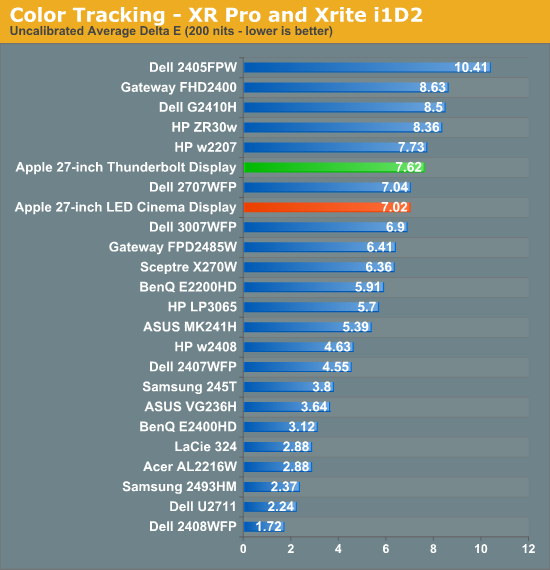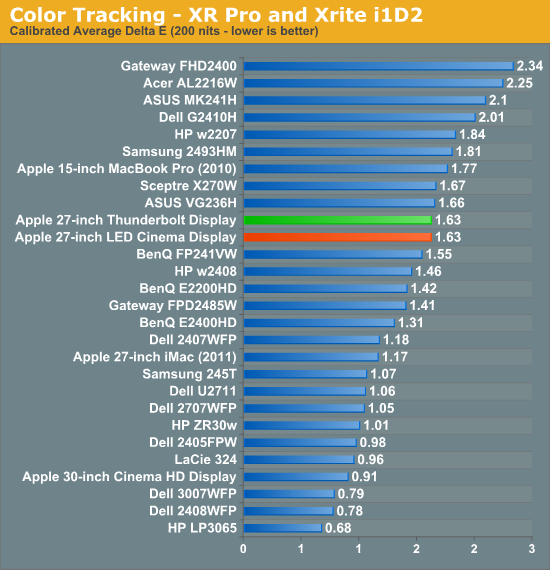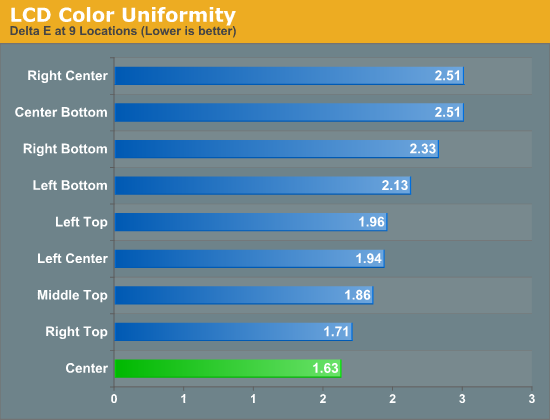The Apple Thunderbolt Display Review
by Anand Lal Shimpi on September 23, 2011 2:56 AM EST- Posted in
- Displays
- Mac
- Apple
- Thunderbolt
- Thunderbolt Display
Display Testing
With all of the extra connectivity there is to test with the Thunderbolt Display we can't forget the actual panel testing. Thankfully this part is pretty simple, the display characteristics are near identical to the 27-inch LED Cinema Display we reviewed last year.
Color Quality
We report two main quality metrics in our display reviews: color accuracy (Delta-E) and color gamut. Color gamut refers to the range of colors the display is able to represent with respect to some color space. In this case, our reference is the AdobeRGB 1998 color space, which is larger than the sRGB color space. So our percentages are reported with respect to this number, and larger is generally better.
Color accuracy (Delta E) refers to the display’s ability to display the correct color requested by the GPU and OS. The difference between the color represented by the display, and the color requested by the GPU is our Delta-E, and lower is better here. In practice, a Delta E under 1.0 is perfect - the chromatic sensitivity of the human eye is not great enough to distinguish a difference. Moving up, a Delta E of 2.0 or less is generally considered fit for use in a professional imaging environment - it isn’t perfect, but it’s hard to gauge the difference. Finally, Delta E of 4.0 and above is considered visible with the human eye. Of course, the big consideration here is frame of reference; unless you have another monitor or some print samples (color checker card) to compare your display with, you probably won’t notice. That is, until you print or view media on another monitor. Then the difference will no doubt be apparent.
As I mentioned in our earlier reviews, we’ve updated our display test bench. We’ve deprecated the Monaco Optix XR Pro colorimeter in favor of an Xrite i1D2 since there are no longer up-to-date drivers for modern platforms.
For these tests, we calibrate the display and try to obtain the best Delta-E we can get at 200 nits of brightness for normal use. We target 6500K and a gamma of 2.2, but sometimes the best performance lies at native temperature and another gamma, so we try to find what the absolute best performance could be. We also take an uncalibrated measurement to show performance out of the box using either the manufacturer supplied color profile, or a generic one with no LUT data. For all of these, dynamic contrast is disabled.

Uncalibrated performance remains fairly similar to last year's LED Cinema Display, however once calibrated the Thunderbolt Display is spot on with its predecessor:

As we mentioned earlier, a sub 2.0 delta E is good enough for professional use. Although not perfect the Thunderbolt Display falls within that range for sure.


We measured slightly lower color gamut on the Thunderbolt Display than the original LED Cinema Display, however the result was much closer to the 2011 27-inch iMac. I couldn't visibly tell any differences and Apple indicates that color gamut shouldn't have changed, so it's quite possible that the differences here are due to our colorimeter and not the panel.
Color Uniformity
Now for color consistency, we take our best calibration profile from the very center at 200 nits and test color accuracy at 9 different places around the LCD display in an evenly distributed grid. We’ve shown before that calibration is localized across the display, partly due to the brightness not being uniform, partly due to the discrete nature of the display itself.

The Thunderbolt Display was fairly uniform across its surface, something we noticed in reviewing the 27-inch LED Cinema Display last year. Uniformity is actually better on this panel than the one we reviewed last year, although in both cases I couldn't really tell any differences.
Peak brightness appears down slightly, but so are the black levels which result in a slightly better contrast ratio. Apple is also calibrating these things at the factory now so white points are now set at around 6300K vs. 7100K on the original 27-inch LED Cinema Display.










275 Comments
View All Comments
repoman27 - Tuesday, September 27, 2011 - link
This is the first display to include ports that have their own host controllers. All other displays either offer just multiple video input ports, or have an internal USB hub and various USB devices that are connected to the USB host controller on a PC via a separate cable. Some also have an audio input as well for a connection to a separate audio output on the PC. So yes, whole different ball game here.I'd rather have a $120k car that doesn't have a stereo or floor mats because they weigh too much. ;-)
I also like displays with height adjustment, but, and not to sound like a total Apple apologist here, Apple generally makes pretty good decisions about which features to include and which to leave out. Whenever you design an electronic gadget you have to make compromises. You can't cram every feature on the market into one device that's smaller and more beautiful than all the others and then sell it for an absurdly low price. The ATD is a pretty balanced package overall. Apple also doesn't have any currently shipping, proven, height-adjustable display stand designs at the moment. If they did, and simply omitted it for this product, it would be far more egregious.
Yeah, stupid consumer HDTV market completely killing the mid-range display market.
AnnonymousCoward - Tuesday, September 27, 2011 - link
The user doesn't care if there's a hub or host directly behind the USB port. It's a friggen USB port, just like my monitor has. And it'd be better if it were USB3, and if there were more than 3 ports. Plug in a mouse and keyboard, and you're quickly left with 1 remaining port, which isn't enough.You don't care to have a stereo in your car? Very odd. I'll take a 15k car with good sound over a silent 120k.
Dell has had their swivel adjustments figured out for several monitor generations. Apple has no excuse, and makes poor feature decisions over and over. Like back when their iPod Shuffle came out, for $90 or whatever and no screen, compared to another brand that cost $35, OLED screen, superior battery life, and functions like a flash drive without iTunes. In addition, Apple's price margins are so high that they can easily afford to add vital features, when competitors have them and sell for less.
repoman27 - Tuesday, September 27, 2011 - link
Of course you don't care how things work, you just buy based on bullet points put forth buy the marketers.How's the throughput on the Gigabit Ethernet port in your display? Does your display have any USB 3.0 ports? Does the PC that it's connected to even have any?
Yeah, and what you consider poor feature decisions have propelled Apple to the #1 ranking market cap in the world. Clearly shareholders are liking the feature set. How's the company that made that other brand doing these days? Dominating the market are they?
AnnonymousCoward - Tuesday, September 27, 2011 - link
Apple is "#1 market cap" because of their marketing department. NOT feature set, nor value.Constructor - Thursday, September 29, 2011 - link
You keep telling yourself that.In the real world, it is actually hard to make the right tradeoffs in product development. And cramming the absolute maximum number of paper features into a product quite often does a disservice to its actual usability and practical usefulness.
Apple's meteoric rise and sky-high user loyalty in large part comes from them in fact making the right decisions in most of these tradeoffs.
"Marketing" is a rather helpless catch-all pseudo-explanation for what many people (and even most competitors) simply fail to grasp. Which is why Apple is successful, and they are not.
AnnonymousCoward - Friday, September 30, 2011 - link
"paper features""disservice to its actual usability and practical usefulness."
-Oh, you mean like a mouse with a right-click button? Yeah, that's quite the paper feature with no practical usefulness!
-Or maybe like putting a screen on an MP3 player. That's yet another worthless paper feature!
-Or a monitor stand with height adjustment. That only looks good on paper! There's no practical usefulness here because every MacHead has a height-adjustable desk!
And don't get me started on the lack of value. You can get a new 15.6" laptop with a C2D-based Intel processor for $280; Apple laptops start at $1000. A while back you could get Apple's 30" (which used an outdated LG panel) for $2000, versus Dell's 30" (with a newer and better LG panel) for $1500, and it had swivel.
I credit the vast majority of Apple's success to their brilliant mass marketing.
crispbp04 - Sunday, September 25, 2011 - link
i just dock my computer and don't have to get flustered over seven cables. snap in and move on. snap off and leave.Constructor - Sunday, September 25, 2011 - link
And all the while there's the massive docking station cluttering up your desk. Which can't be used with any other computer and cannot be adapted to should you need anything it doesn't happen to provide.I'm not saying that it can't be useful, just that Thunderbolt is quite a bit more flexible, more powerful and more convenient.
dsumanik - Tuesday, September 27, 2011 - link
How is that different from a piece of wood or a stack of books for the display to sit on because there is no height adjustment?Constructor - Tuesday, September 27, 2011 - link
You'll need a display in addition to your docking station. The TBD already covers the docking needs, and you can still use the Air's keyboard and trackpad if you like, since there's only one thin cable going out from it, not much different from a USB keyboard cable.And as I explained before: Height adjustment built into the regular stands is usually too limited to be really useful where it's actually needed, and still fragile and wobbly at the same time (which is two things the iMac / Thunderbolt Display stand most certainly is not).
Theoretically demanding all kinds of things is one thing. Ticking them off on a theoretical spec sheet is another.
But the actual, practical reality is usually a completely different thing again. And that is what you have to deal with when you're actually constructing real-life hardware. It's not nearly as simple as is looks from the outside (I'm developing software, hardware and sometimes mechanical components for a living myself).
Bitching is easy. Finding really good solutions for difficult problems is not.